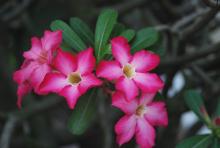Adenium obesum
Common name:
Desert Rose
Desert Azalea
Mock Azalea
Pronunciation:
a-DEE-nee-um oh-BEE-sum
Family:
Apocynaceae
Genus:
Type:
Broadleaf
Native to (or naturalized in) Oregon:
No
- Succulent, thick-stemmed shrub, crooked branches, often evergreen in cultivation, but deciduous in dry seasons, in cultivation to about 5 ft (~1.5 m) high. Leaves simple, lanceolate-obovate, in a loose spiral, crowded near stem tips, 5-15 cm long and about 0.6 cm wide, often glossy, margin entire, base tapering into a short petiole. Flowers showy, trumpet shaped, 2-5 × 4-6 cm, in small terminal clusters; red or pink, rarely white, sometimes with a white center or "eye". Fruit are slender, green, pod-like follicles up to 4 inches (10 cm) long; when mature they split open to release many long, narrow, silky seeds.
- Sun or part shade, best in a climate with a dry season. Most often grown in a pot with a porous, well-drained medium. Avoid waterlogging as they are very prone to rotting. Often grown as a house plant in temperate climate, minimum temperatures of about 50°F (10°C).
- Hardy to USDA Zone (10?)11 (tropical) Native to tropical Africa, Arabia.
- Caution: The plant exudes toxic latex and all parts are poisonous if ingested. Reportedly in wide areas of Africa the root sap or sometimes the wood or stem latex of Adenium obesum is used to prepare an arrow poison.
- obesum: stout, plump; a reference to the thick, swollen trunk (caudex), sometimes almost entirely below ground.





